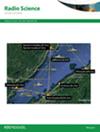Isolation enhancement in H-plane coupled 5G MIMO antenna with tight spacing using miniaturized epsilon negative (ENG) metamaterial
IF 1.5
4区 地球科学
Q3 ASTRONOMY & ASTROPHYSICS
引用次数: 0
Abstract
A novel miniaturized epsilon negative metamaterial is proposed vide this article to address coupling in a tightly spaced H-plane configured two-element multiple input multiple output (MIMO) antenna operating at the globally popular 5G NR (new radio) band of 3.5 GHz frequency. Wave evanescence exhibited by the devised metamaterial unit element (MTM UE) (4.2 × 4.2 sq.mm) at 3.5 GHz resonance is verified by interposing the MTM UE array (5 × 1) in an MIMO antenna with an edge-to-edge spacing of 5 mm. Each radiator constituting the MIMO array (37 × 80.6 sq.mm) is a modified rectangular patch antenna with dimensions 27 × 33.4 sq.mm that are excited by the cost-effective microstrip transmission line. After the insertion of the proposed MTM unit element, the port isolation reported is <—20>9.8 dB) and Envelope Correlation Coefficient (<0.04) values from the radiation pattern, which adhered to the acceptance rate. Proposed MTM UE even rendered improved radiation gain with negligible impact on the efficiency. To verify the evanescence mechanism in real-time, the prototype covering the two-element MIMO with the proposed miniaturized MTM UE is fabricated and tested, which presents a perfect agreement. All these features make the proposed design viable for Wi-Max (IEEE 802.16e) (3.4–3.5 GHz) technology dedicated to space-constrained modern wireless applications. In addition, this article also presents the RLC equivalence derived for the proposed MTM UE and the two-element MIMO antenna.小型化负epsilon (ENG)超材料增强h平面耦合5G MIMO天线的隔离
本文提出了一种新型小型化epsilon负超材料,用于解决在全球流行的3.5 GHz 5G NR(新无线电)频段工作的紧密间隔h平面配置的双元多输入多输出(MIMO)天线中的耦合问题。设计的超材料单元单元(MTM UE) (4.2 × 4.2 sq.mm)在3.5 GHz共振下表现出的波倏逝特性通过将MTM UE阵列(5 × 1)插入到边沿间距为5mm的MIMO天线中得到验证。构成MIMO阵列的每个辐射体(37 × 80.6平方毫米)是一个改进的矩形贴片天线,尺寸为27 × 33.4平方。Mm是由具有成本效益的微带传输线激发的。在插入建议的MTM单元元件后,报告的端口隔离为9.8 dB)和包络相关系数(<0.04)值与辐射方向图一致,符合接受率。所提出的MTM UE甚至在对效率的影响可以忽略不计的情况下提高了辐射增益。为了实时验证消失机制,制作并测试了覆盖两元MIMO的原型机,该原型机与所提出的小型化MTM UE完全吻合。所有这些特性使得所提出的设计适用于专用于空间受限的现代无线应用的Wi-Max (IEEE 802.16e) (3.4-3.5 GHz)技术。此外,本文还介绍了所提出的MTM UE和双元MIMO天线的RLC等效性。
本文章由计算机程序翻译,如有差异,请以英文原文为准。
求助全文
约1分钟内获得全文
求助全文
来源期刊

Radio Science
工程技术-地球化学与地球物理
CiteScore
3.30
自引率
12.50%
发文量
112
审稿时长
1 months
期刊介绍:
Radio Science (RDS) publishes original scientific contributions on radio-frequency electromagnetic-propagation and its applications. Contributions covering measurement, modelling, prediction and forecasting techniques pertinent to fields and waves - including antennas, signals and systems, the terrestrial and space environment and radio propagation problems in radio astronomy - are welcome. Contributions may address propagation through, interaction with, and remote sensing of structures, geophysical media, plasmas, and materials, as well as the application of radio frequency electromagnetic techniques to remote sensing of the Earth and other bodies in the solar system.
 求助内容:
求助内容: 应助结果提醒方式:
应助结果提醒方式:


